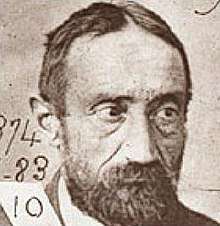Michael Ostrog
Michael Ostrog was a Russian criminal and Jack the Ripper suspect, first proposed in a memorandum by Sir Melville Macnaghten in 1894.
Michael Ostrog | |
|---|---|
 Mugshot | |
| Born | c. 1833 |
| Died | After 1904 |
| Occupation | Scam artist, Fraudster |
| Conviction(s) | Theft, Scamming, Fraud, Robbery, Attempted Murder |
| Criminal penalty | Various |
Ostrog was a swindler with a profuse police record who perpetrated multiple scams and frauds, but it was never proven that he committed any murders. According to relatively recent investigations, during 1888 he was imprisoned in France, and such a circumstance would rule out his participation in any of the Whitechapel murders.
Criminal biography
Born in Russia circa 1833, little is known about his early years. Ostrog became known after emigrating to England, because in 1863, at age 30, he committed his initial robbery at the University of Oxford, while using the alias of Max Grief. On that occasion, he was arrested and sentenced to ten months in jail.
The following year, Ostrog was again locked up for three months for various frauds consummated in the city of Cambridge. In December 1864, he was sentenced for eight months, yet again, for fraud. In August 1866, he was given seven years in prison for a series of robberies, mostly stealing gold watches from a jewelry store in Maidstone.
In 1873, Ostrog left prison and soon undertook another succession of thefts. He was arrested and taken to the police station in Burton upon Trent, where he resisted and tried to fire a gun upon the officers. In January 1874, as a result of robberies, contempt and attempted murder, he was sentenced to 10 years imprisonment, and would be released in 1883. Four years later, in July 1887, Ostrog stole the trophy from a cricket contest, and was sentenced to six months in prison.
Freed again in March 1888, prison authorities considered him cured. However, in an article by Police Gazette, it was argued that he was very dangerous. On September of that year, while in Paris, France, he committed another robbery and was sentenced again. He then left and returned to England. In 1891, he was admitted to an asylum in Surrey.
After this seclusion, Ostrog continued to periodically leave and enter prisons for thefts, scams and frauds until 1904, the year any information about him ceases to be published. It is presumed that he died from then on.[1]
From professional fraudster to alleged serial killer
This man - as seen in the previous section - was a well-known professional scammer who used various costumes to improve the chances for a successful scam. He also used a variety of aliases for the same purpose, always seeking to surround himself with an air of mystery, and spread all kinds of lies about his life and activities. One of his most creative hoaxes was to repeatedly claim that he worked as a surgeon in the Russian Navy. However, this was just another of his numerous lies.[2]
Even though in the memorandum of the Scotland Yard chief, Sir Melville Macnaghten, Ostrog was pointed at as a Jack the Ripper suspect, the investigators did not find evidence of violent wrongdoing in his past, much less homicide. His criminal record only included theft and scams, making him a white collar criminal.[3][4]
In the 19th century, Philip Sugden, an expert on the Jack the Ripper case, located police records in which it was stated that Michael Ostrog had been charged with minor crimes and imprisoned in France in 1888, during the period of the murders.[5]
Obviously, such verification reliably endorses the innocence of the Russian pseudo-doctor, erasing the misgivings that for a long time fell upon him in 1894, in the "Macnaghten Memorandum", as the probable killer of the prostitutes.[6]
Notes and references
- Michael Ostrog, suspect, sitio digital Casebook Jack the Ripper.
- Paul Begg, Jack the Ripper the uncersored facst, Editorial Robson, Londres, Inglaterra (1988), págs. 197-198.
- Stewart Evans, Keith Skinner, The ultímate Jack the Ripper Soucebook, Editorial Constable and Robinson S.A, Londres, Inglaterra (2001), págs. 652-653.
- Nuria Janire Rámila, La maldición de Whitechapel, Editorial Aladena, Barcelona, España (2010), pág. 285.
- Philip Sugden, The complete history of Jack the Ripper, editorial Da Capo Press, Londres, Inglaterra (1994).
- Melville Leslie McNaghten, Days of my Year, Editorial, Hard Press, Londres, Inglaterra (reimpresión 2012).
See also
External links
- Biography of Michael Ostrog with some photos of the suspect
- Michael Ostrog (b. 1833, suspect) on the digital site Casebook: Jack the Ripper
| Wikimedia Commons has media related to Jack the Ripper. |